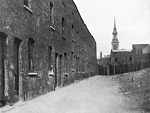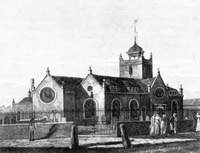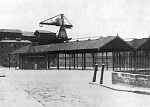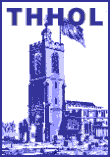Shadwell High Street is actually part of the old Ratcliff Highway, and at one time shared with what is now St. George Street its unsavoury reputation. Any contrast which it may have presented during the first half of the nineteenth century was due to the western portion of the highway being associated with occasional disorderly behaviour of seafarers of all nationalities, who after all brought money into the pockets of shopkeepers and others, while the Shadwell side of it was affected by the poverty of a rough class of population inhabiting the area situated between it and the river. The money-making parish of St. George looked askance at the neighbour who offered so little and wanted so much in the way of charity and the hamlet of Ratcliff on its eastern boundary thought of the proximity of Shadwell as one of the evils which had to be borne, but less so when not a few of the poor people overflowed into their own district. Local feeling or pride long endeavoured to maintain certain distinctions of status without defining precisely what they were, but at least it would not be admitted that anything like class equality existed. Therefore Shadwell was cold-shouldered, and left to work out its own salvation; but there was a shudder of fear as it was realised that here was one of the places in London where typhus cases were to be expected. The fault of Shadwell was that it had not well-to-do families living in it as was the case in the other parts of Stepney.
 Lower
Shadwell - the part nearest the river - was poverty-stricken and many of the houses had fallen
into a very bad state caused by the occupiers of the tenements rather than by the wilful neglect
of the owners of the property. As time went on the conditions of life were improved, but anyone
who can recall the appearance of High Street (sometime called Upper Shadwell), say, for instance,
in 1880, comparing it, after the lapse of years, as it was then with its present aspect, will
find it difficult to identify the place, so great has been the transformation. The pretty spire
of St. Paul's Church is familiar enough, but it seems, when looked at from the east, to have
been lifted from out of its former mean surroundings and set down where it is to add charm and
grace in the distance to the vista along the terrace in the King Edward VII Memorial Park.
Lower
Shadwell - the part nearest the river - was poverty-stricken and many of the houses had fallen
into a very bad state caused by the occupiers of the tenements rather than by the wilful neglect
of the owners of the property. As time went on the conditions of life were improved, but anyone
who can recall the appearance of High Street (sometime called Upper Shadwell), say, for instance,
in 1880, comparing it, after the lapse of years, as it was then with its present aspect, will
find it difficult to identify the place, so great has been the transformation. The pretty spire
of St. Paul's Church is familiar enough, but it seems, when looked at from the east, to have
been lifted from out of its former mean surroundings and set down where it is to add charm and
grace in the distance to the vista along the terrace in the King Edward VII Memorial Park.
Until the middle of the seventeenth century this part of the Highway passed through open country, and few were the houses in its immediate vicinity. It was a much used thoroughfare, and, therefore, an inn or two with stabling for the horse had an important place in the everyday life. On the north side lay Ratcliff Fields, which were later distinguished as Sun Tavern Fields. They extended from Blue Gate Fields eastwards as far as the grimly named Cut-throat Lane, now known, however, as Love Lane. From there gravel was obtained and carried down to the Thames to supply the ballast for the ships hence the derivation of the names of Old Gravel and New Gravel Lanes. While excavations were being made in 1614 Roman remains were unearthed, of which Sir Robert Cotton, the antiquary, gave a particular description. He stated that a chest of lead "had its upper part garnished with scollop shells in a border. At the head and foot of the coffin stood two jars three feet long, and on the sides a number of bottles of glistening red earth, some painted, and many great phials of glass, some six, some eight square, having a whitish liquor in them. Within the chest was the body of a woman (as the surgeons judged by the skull). On either side of her were two sceptres of ivory eighteen inches long, and on her breast a little figure of Cupid, neatly cut in white stone" - a little figure of a Cupid cut in white stone! When the lasting adieu was taken it was little expected that the curiosity of the future ages should make comment on these relics which "are memorials of themselves and momentoes of mortality." Not far away there were the remains of a man in a stone coffin. It was considered that both had lived and died about A.D. 235, there being also found various coins of that period.
In these same fields, when sinking a well in 1745, a mineral spring was met with which, it was said, was impregnated with "sulphur, vitriol, steel, and antimony." On account of its alleged uncommon curative qualities it received the imposing title of Shadwell Spa. It may here be said that this well has nothing whatsoever to do with the origin of the name of Shadwell. Possibly the spring may have supplied the well mentioned by Harrison nearly two hundred years previously in his Description of England. He says [1579]: "I hear of another well being found also about Ratcliffe neere London even at the same season." Wealth, Wit and Fashion did not flock to the spot despite the vaunted virtues of the water, which, it is said, was subsequently employed for extracting salts and for preparing a liquor which calico printers used to fix their colours. Likely enough it was tried for these purposes, but either the experiment or the well failed, for after having been a sort of a nine days' wonder the water fell into the sea of oblivion.
 In
the previous notes on Shadwell a brief account is given of Thomas
Neale, a remarkable man who, during one of his various speculative ventures, came to the
hamlet and made it a little town which was afterwards constituted a parish. He must certainly
be recognised as a pioneer of town-planning, although no buildings remain whereby to judge him.
The structures he reared would have been largely of timber, and these by sundry fires and by
decay had disappeared by the dawn of the nineteenth century, when meanly-built brick cottages
for the most part took their place. The fact that it was through Neale (by whose munificence
a chapel had been founded in Cromwellian days) that the first parish church was erected; that
he built a market-place and secured a charter for it, and, what is more, had waterworks constructed,
converting the river inlet (then millstreams) to this purpose, all go to indicate a defined
scheme of operations having been efficiently carried out. During the twenty years following
1656, 289 houses were built. In 1732 the number had increased to 1800. These must have been
in somewhat close proximity considering the size of the parish - roughly 900 yards by 750 yards
- and the amount of ground within it which remained vacant for many years afterwards...
In
the previous notes on Shadwell a brief account is given of Thomas
Neale, a remarkable man who, during one of his various speculative ventures, came to the
hamlet and made it a little town which was afterwards constituted a parish. He must certainly
be recognised as a pioneer of town-planning, although no buildings remain whereby to judge him.
The structures he reared would have been largely of timber, and these by sundry fires and by
decay had disappeared by the dawn of the nineteenth century, when meanly-built brick cottages
for the most part took their place. The fact that it was through Neale (by whose munificence
a chapel had been founded in Cromwellian days) that the first parish church was erected; that
he built a market-place and secured a charter for it, and, what is more, had waterworks constructed,
converting the river inlet (then millstreams) to this purpose, all go to indicate a defined
scheme of operations having been efficiently carried out. During the twenty years following
1656, 289 houses were built. In 1732 the number had increased to 1800. These must have been
in somewhat close proximity considering the size of the parish - roughly 900 yards by 750 yards
- and the amount of ground within it which remained vacant for many years afterwards...
Some years before the little township was formed there came into the Highway a certain John Shakespear, who established a rope-walk. He settled down to his business, which flourished. For his first wife in 1642 he chose Margaret Judd, widow, of Stepney. He married a second time in 1658 at the age of thirty-five, "Martha Seeley of Wapping Wall, mayde, 19 years." The register of Stepney Church records, in 1652, the burial of Margaret, wife of John Shawespeare of Ratcliff Highway, ropemaker." The variation in the spelling of the surname is one of the many to be found in the books of St. Paul's, Shadwell, and St. Dunstan's, Stepney, where members of three generations of the family were baptised, married, and, having lived life's little day, were interred. Even the name of the rope-walk became corrupted and was vulgarly called Shagsby's Walk after it had ceased to be used for its original purpose. It became a residential quarter - a court some 850 yards long with trees planted down the middle... It reached from the Highway to Wapping Wall, but has now entirely disappeared, the greater portion of it having been taken to form the Shadwell Basin of the London Docks. There has always existed a supposition that this John Shakespear of Ratcliff Highway was descended from one of the poet's uncles - Henry or Thomas - who may have had children that have not been traced. Despite close search of records all efforts to prove the relationship have been in vain.
The increase of trade in sea-borne coal brought a certain sort of prosperity to the riverside, but destroyed the character of a pleasant suburb which had for its earlier inhabitants those who were engaged in marine occupations and kindred trades. By the middle of the eighteenth century the demand for unskilled labour, especially for coal-heaving, had brought into Shadwell the rough, uncouth population.
Accommodation for these people was provided by the making, in the existing streets, of courts and alleys, which, by the very names by which they were known, imply that they covered back yards of inns or occupied the sites of the once garden ground of the older houses. However, as the number of the inhabitants increased through the demand for manual labour the number of houses decreased, which means that overcrowding took place in tenements. What a different tale might have been told if mechanised power had been invented at the time! Unfortunately in the days of sail so much depended on the weather that employment was hazardous. For instance, the prevalence of contrary winds not permitting ships to enter the Thames, or frosts not rendering the river navigable, would bring about sudden destitution and misery. The employers, often a class of middlemen who were keepers of public-houses, undertook to provide labour for the discharge of cargoes. Trouble was always rife, but the most serious of all disturbances occurred in 1768 - a year of high prices of provisions. The coal-heavers complained that they were ill used, that their wages were withheld, and that, instead of being paid in money, they only received liquor and goods of bad quality. The discontent was general along the riverside and led to frays between the coal-heavers and the sailors, who apparently had been induced to oppose them. On one occasion several sailors were killed in Stepney Fields and the coal-heavers marched off in triumph. In Sun Tavern Fields (near where a riot had been committed) seven coal-heavers were hanged for shooting at Mr. Green, the proprietor of the Roundabout Tavern in Shadwell. It is not stated if Mr. Green was killed or even hit. These public executions, a writer drily remarks, "produced the wished-for effect: the tumults immediately ceased, and peace and industry was happily restored."
In the nineteenth century the demand for labourers of powerful physique caused a large influx of Irish. They were induced by what seemed to them a high rate of pay, and came over from the wilds of the "Emerald Isle," where they lived healthily among pigs and cows under conditions of their own which were very different to those to be observed in town life. It is, therefore, not to be wondered at that they were unable to raise themselves to that standard which was necessary for the welfare of the community. In 1816 it was reckoned "there were 14,000 Irish in the Shadwell parishes," which means that place and the district adjoining it. Their work was extremely irregular and heavy drinking was forced on them by the middlemen of the trade. This brought about dissoluteness and disorder, to cope with which there existed no police force for the keeping of the King's Peace. Licensing scandals existed, and Shadwell was well supplied with public houses - "Paddy's Goose" is, in fact, within the parish. The comparatively small number of houses having regard to the population brought about sub-letting to families, each occupying one room, which was often bared of wooden fittings as the result of having fuel to hand.
The great improvement in the social condition of the neighbourhood was brought about during the sixty years following owing to the police, education, the Board of Works, and the unselfish labours of men of courage and good will.
 A
special Act of Parliament was obtained in 1882 to establish a Fish Market and to clear four
acres of land for the purpose. The right to hold a market is a great privilege to be obtained
only at considerable cost by statute, the Corporation of the City of London preventing by Charter
the establishment of any market within a distance of seven miles of any part of the City. The
project was conceived by Mr. C. Dunch, the Surveyor of the Limehouse Board of Works, and among
the names of the directors appeared those of Messrs. Spencer Charrington, Edward Rider Cook
and Theodore H. Bryant, all well-known in the eastern parts of London. The market was a failure
and, as before related, the site of it is now within the King Edward VII Memorial Park.
A
special Act of Parliament was obtained in 1882 to establish a Fish Market and to clear four
acres of land for the purpose. The right to hold a market is a great privilege to be obtained
only at considerable cost by statute, the Corporation of the City of London preventing by Charter
the establishment of any market within a distance of seven miles of any part of the City. The
project was conceived by Mr. C. Dunch, the Surveyor of the Limehouse Board of Works, and among
the names of the directors appeared those of Messrs. Spencer Charrington, Edward Rider Cook
and Theodore H. Bryant, all well-known in the eastern parts of London. The market was a failure
and, as before related, the site of it is now within the King Edward VII Memorial Park.
The old parish church of St. Paul's, Shadwell, which was consecrated on 12 March 1670-71, was taken down in 1817 when the present edifice designed by John Walters was erected. Bishop Butler as Dean of St. Paul's nominated his nephew and namesake to the living. "He liked it so little," we are told, "that he chose for the text of his first sermon:-
'Woe is me, that I sojourn in Mesech, that I dwell in the tents of Kedar!'
A canonry in St. Paul's and permission to reside in Norfolk Street, Strand, so far reconciled him to his fate that he managed to hold the rectory fifty-seven years."
by Sydney Maddocks
Go to "Shadwell" (1932) by Sydney Maddocks
